Living Aboard
What kind of coffee maker do you use aboard your boat? Recently, we posted this question to readers on Facebook. Responses revealed clear-cut winners — none require electricity, and all you need is a stove to heat water. A few readers with regular access to shore power or an onboard inverter singled out electric K-Cup coffee makers, such as Nespresso, Keurig or Nescafe Dolce Gusto, but the vast majority preferred simpler options.
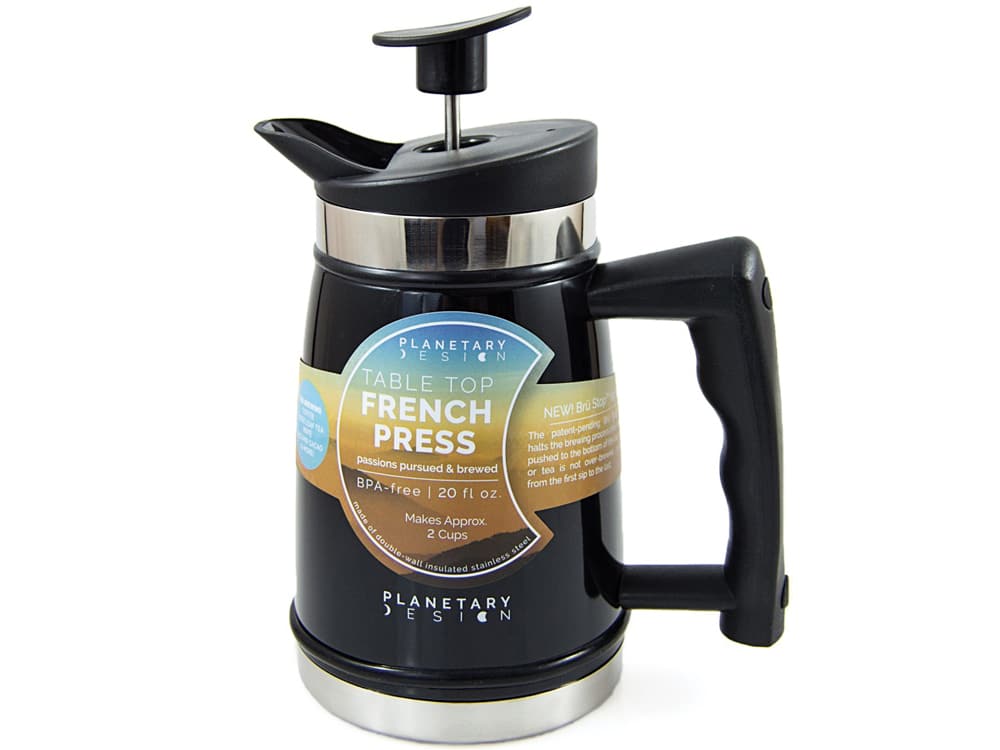
Pressed Coffee (the Immersion Method)
1. The Winner: French Press
This classic press was the overall favorite; users claim it makes the best-tasting cup of coffee, hands down. The design is simple: a cylindrical glass or metal carafe and plunger/lid with mesh filter. Just add hot water to ground coffee in the carafe, allow it to brew, then press grounds firmly to the bottom. Invented in France in the 1800s, the aptly named French press didn’t gain popularity in the United States until the mid-1970s and ’80s, when Danish company Bodum designed its own unit and launched a literal full-court press on the worldwide retail market.
Brewing Tips: Use hot, not boiling, water and coarse-ground coffee. Measure coffee into the carafe; add a small amount of hot water; let coffee puff up, or “bloom”; stir. Add remaining water, and let brew for three to five minutes before gently plunging. Brew time: about five minutes (excluding water-heating time).
Pros: Sweet, full-bodied coffee. Easy to use. Widely available; multiple styles (insulated stainless steel, glass, plastic), sizes and prices.
Cons: Cleanup can be messy. Occasional sludge in coffee, the occurrence of which varies depending on quality (and condition) of press and filter.
Good Bets: Planetary Design’s high-quality Table Top French press with Brü-Stop is ideal for onboard use: New technology creates a barrier between grounds and brewed coffee, so it never gets bitter. Its stainless-steel mesh screens ensure a clean brew (sizes small, medium, large; $40-$60). Bodum continues to make high-quality coffee presses, such as the thermal/stainless-steel Columbia; three sizes ($60-$80); also available on amazon.com. The Espro Press (also sold by Starbucks) is attractive and durable, with a vacuum-sealed/insulated double-walled stainless-steel carafe. A double micro filter guarantees sludge-free brew (sizes medium, large, $100-$120).
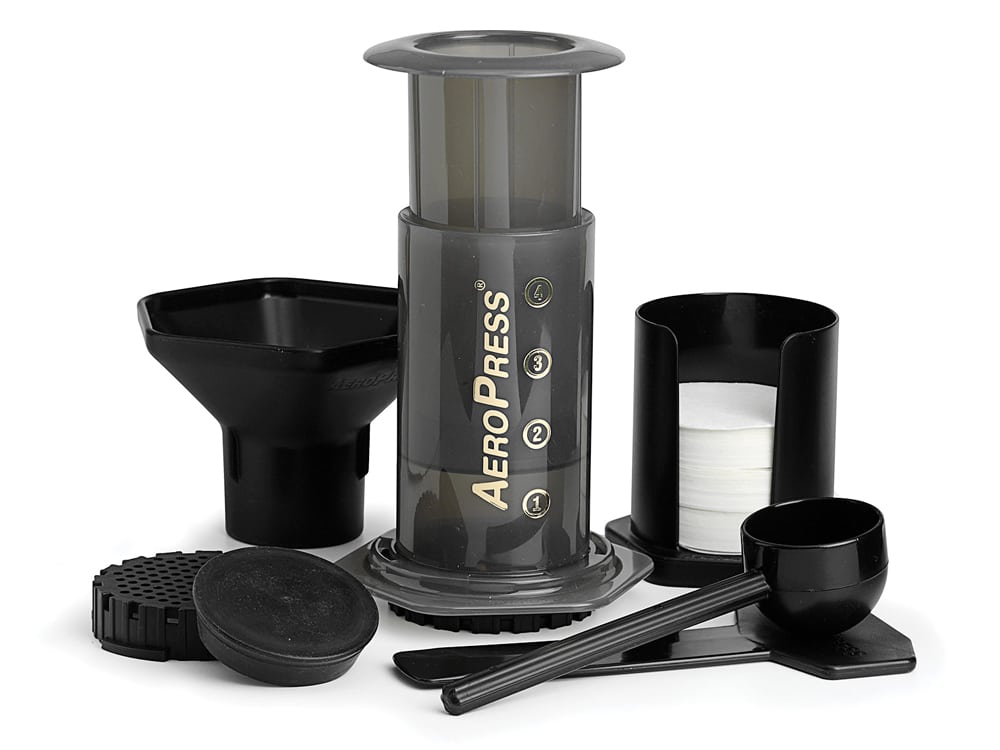
2. AeroPress
A close second to the French press was the less-familiar (but equally praised) AeroPress by Aerobie, invented and launched in 2005 by Alan Adler, an aerodynamic-toy designer. It’s a sleek, small, one-of-a-kind device: a cylindrical plastic chamber and plunger, filter cap with seal and a funnel, for placing over individual cups. Just scoop coffee into the chamber, add water, stir 10 seconds and gently plunge. The result is a liquid coffee concentrate. For Americano coffee, add water to fill a cup; for latte or cappuccino, add milk. For espresso — pronto! — it’s ready (amazon.com; about $30, price varies by retailer).
Brewing Tips: Heat water to a maximum temperature of 175 degrees Fahrenheit (185 degrees for light roasts). Use espresso- or fine-drip-grind coffee. Brew time: about one minute, excluding water-heating time.
Pros: Compact; portable (available with a zippered nylon tote bag); lightweight; quick; easy cleanup; used grounds can be ejected; makes excellent coffee.
Cons: Only makes one to three cups at a time.
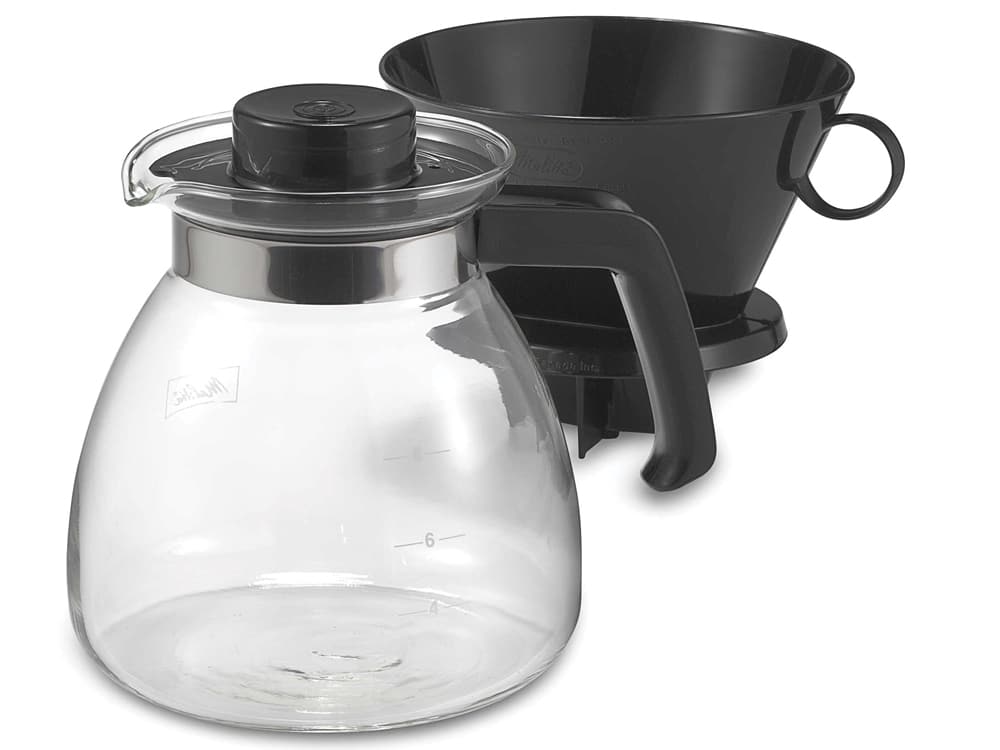
3. Manual-Drip Coffee Makers (the Pour-Over Method)
This method was pioneered about a century ago by Dutch housewife Melitta Bentz. Evidently fed up with the lingering grounds in boiled coffee, she made the first pour-over filter using a perforated brass cup and a sheet of blotting paper. Today’s familiar coffee makers that bear her name are now synonymous with pour-over coffee. The technique is simple: Measure coffee into a filter-lined cone that fits snugly over a carafe (or cup), and pour hot water over coffee; it brews as water slowly drips through the filter.
Brewing tips: Use hot, not boiling, water. Add a small amount first; wait 30 seconds for coffee to bloom. Add remaining hot water slowly, in a circular motion. Brew time: about five to 10 minutes (excluding water- heating time).
Pros: Simple to use. Easy cleanup. Thermal carafes available; filters come in multiple sizes, including one-cup. Slow-drip method draws out flavor.
Cons: You can’t walk away while coffee brews. For a full pot, the slow-drip process can take time.
Good Bets: The Melitta thermal pour-over and stainless carafe (10-cup) is one of the few insulated stainless-steel/pour-over “sets” available (amazon.com; $30-$50); glass carafe sets are widely available. For one- or two-cup brewing, a patented filter device that’s both a pour-over and immersion brewer is worth a look: The Clever coffee dripper brews coffee right in the self-contained filter; a built-in lever automatically releases the brew when the cone is placed over a cup or small carafe (small, large; $15-$18; amazon.com).
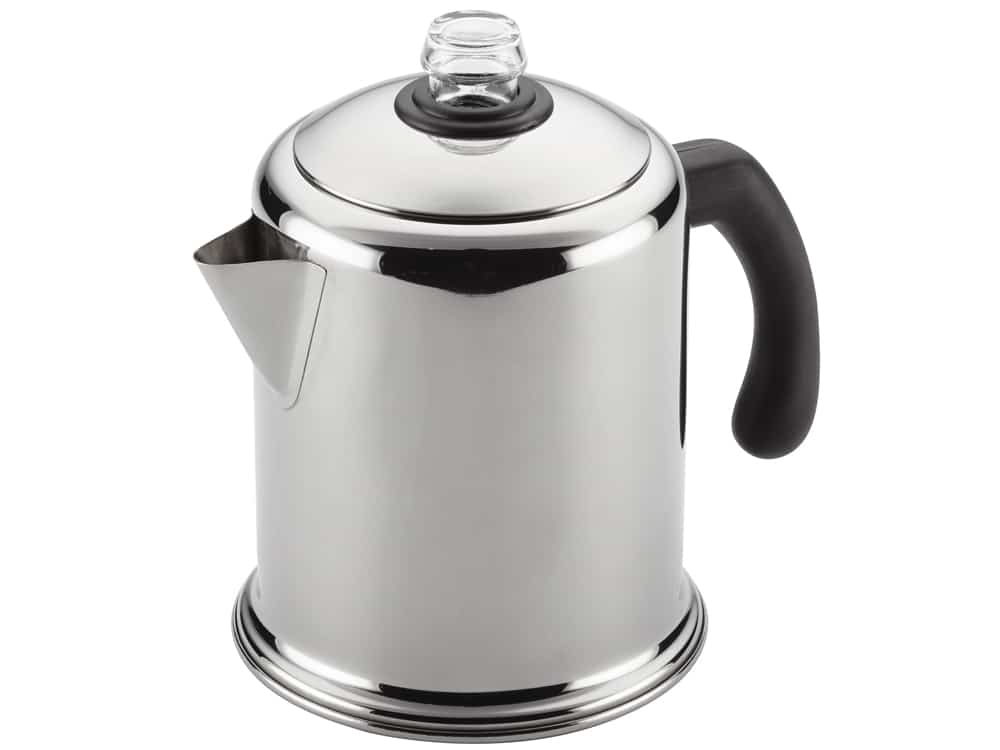
4. Stove-top Percolators
Many readers remain faithful to stove-top percolators for onboard brewing. When water is heated in percolator pots on the stove-top, very hot water is drawn upward through a metal tube, cycling continuously through ground coffee in an attached filter basket, brewing coffee by cycling almost-boiling water through it. Enthusiasts say they prefer the resulting very hot coffee, as well as its stronger taste. The stove-top coffeepots still in use today were patented by an Illinois farmer in 1889, who called his brewing method “percolating” — hence forever coining the generic name.
Brewing Tips: Use coarse-ground coffee, moderate heat and avoid boiling. When perks are audible/visible, begin timing (maximum 10 minutes). Prolonged perking results in very bitter coffee. Remove filter and grounds before pouring. Brew time: about 20 minutes, depending on stove/heat setting.
Pros: Inexpensive, widely available and easy to use. Makes a strong, hot cup of joe.
Cons: Cleanup can be messy. Stray coffee granules can end up in brew. Takes time. Must be watched or timed carefully.
Good Bets: Farberware’s classic stainless-steel Yosemite eight-cup (amazon.com; $25) and Chinook’s Timberline six-cup ($27) or nine-cup (about $40) offer heavy-duty, high-grade stainless-steel construction, dent-resistance and durability (available at amazon.com).
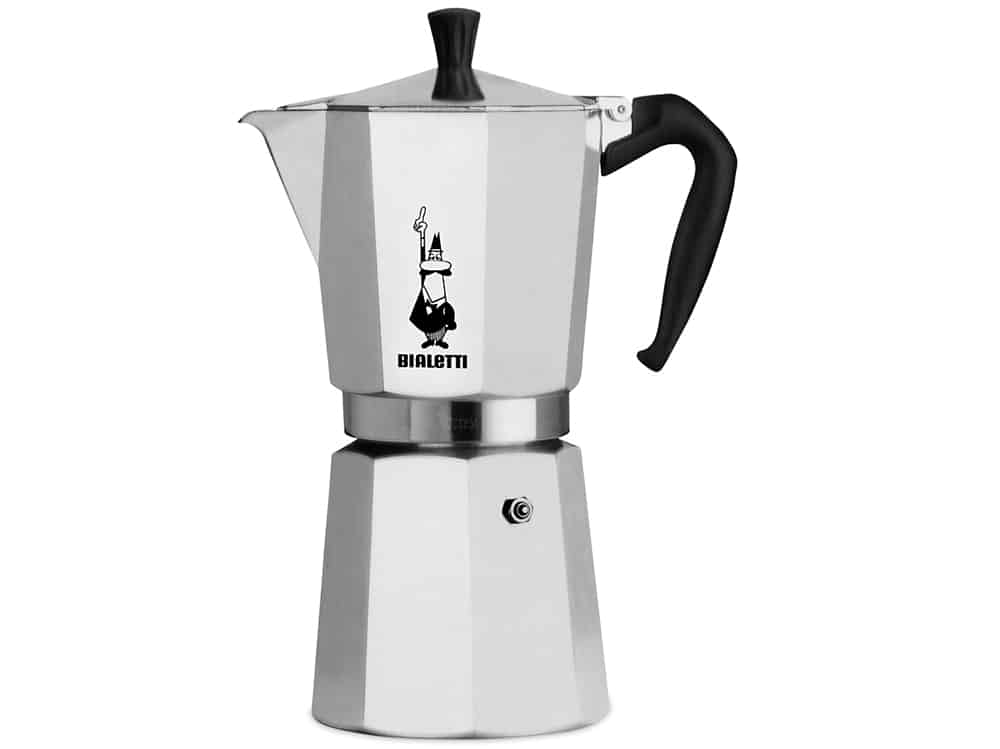
5. Nonelectric Espresso Makers
Espresso fans were in the minority, but singled out some specific products (almost none of them electric).
Stove-Top: The Moka pot: Made of aluminum or stainless steel, two screw-together compartments plus a filter basket with tube fit together to make the complete pot. Just add water to the lower section and fit the filter basket holding coffee just above it. Screw top on and heat; water and steam are forced up through the coffee and into the upper container to create the brew. The first Moka pot was patented in Italy for manufacturer Alfonso Bialetti in 1933; Bialetti is still a market leader. Other popular brands include Cuisinox (pricey), Vremi and Amfocus.
Brewing Tips: Use espresso or Moka-grind coffee. Preheat water to avoid prolonged boiling. Use moderate heat. Lower heat when caramel-colored coffee spurts into top section (some leave lid open). Stir and pour immediately after top container is full. Brew time: about five minutes.
Pros: Various models and styles available. Unbreakable. Stable when placed on stove-top. Versatile. Makes espresso or (strong) conventional coffee.
Cons: Cleanup can be messy. Uninsulated handles get very hot. Must be watched carefully (not boiled) to avoid scorching coffee.
Good Bets: The Bialetti Moka Express (largely unchanged from the original design) remains one of the best. The octagonal pot is designed to diffuse heat for ideal coffee flavor. Available in one- to 12-cup sizes (bialetti.com, $25-$60). The Bialetti Venus four- or six-cup is stainless steel with an insulated handle, and can be used on all stoves, including induction ($40-$45); also available at amazon.com.
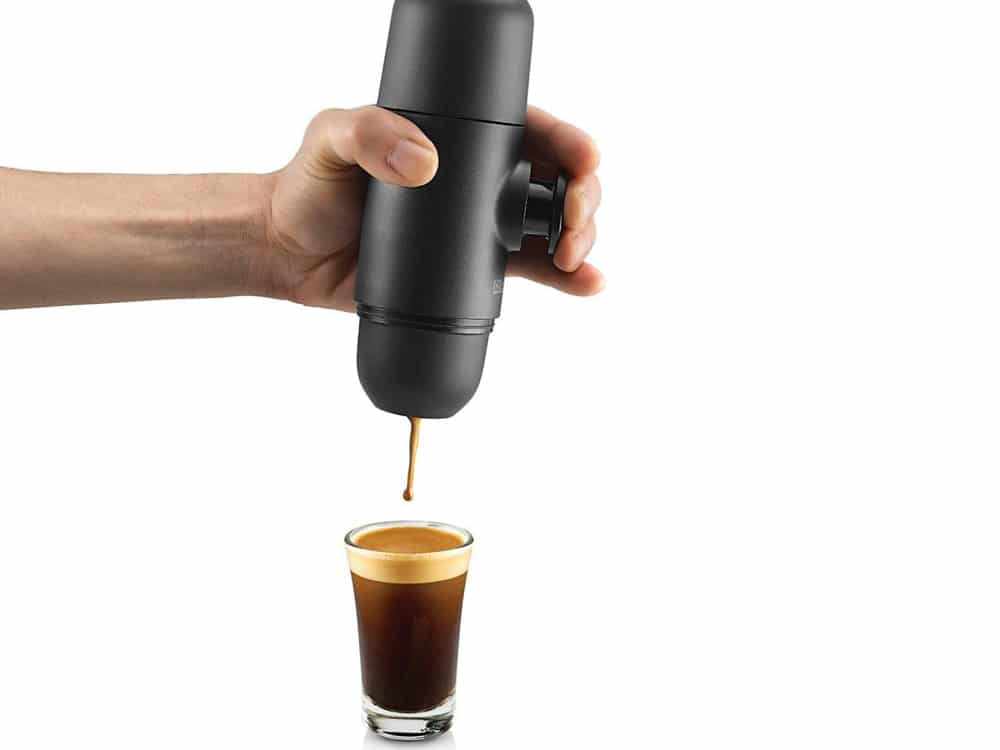
Espresso On The Go: The Minipresso and the Handpresso are unique, portable units that can go anywhere; all you need for a quick espresso fix is a way to heat water (or hot water from a thermos). Both use a hand-pump pressure-brewing technique (like pumping a miniature bicycle tire). Neither requires electricity or batteries, and they can also make Americano coffee — a shot of espresso with hot water added — or even cappuccino if you’ve got milk.
The Minipresso GR by Wacaco is lightweight and compact. Wacaco makes another model, the Minipresso NS, which is for use with Nespresso coffee pods. It includes a built-in espresso cup and scoop; a small carry bag is available (amazon.com; $50).
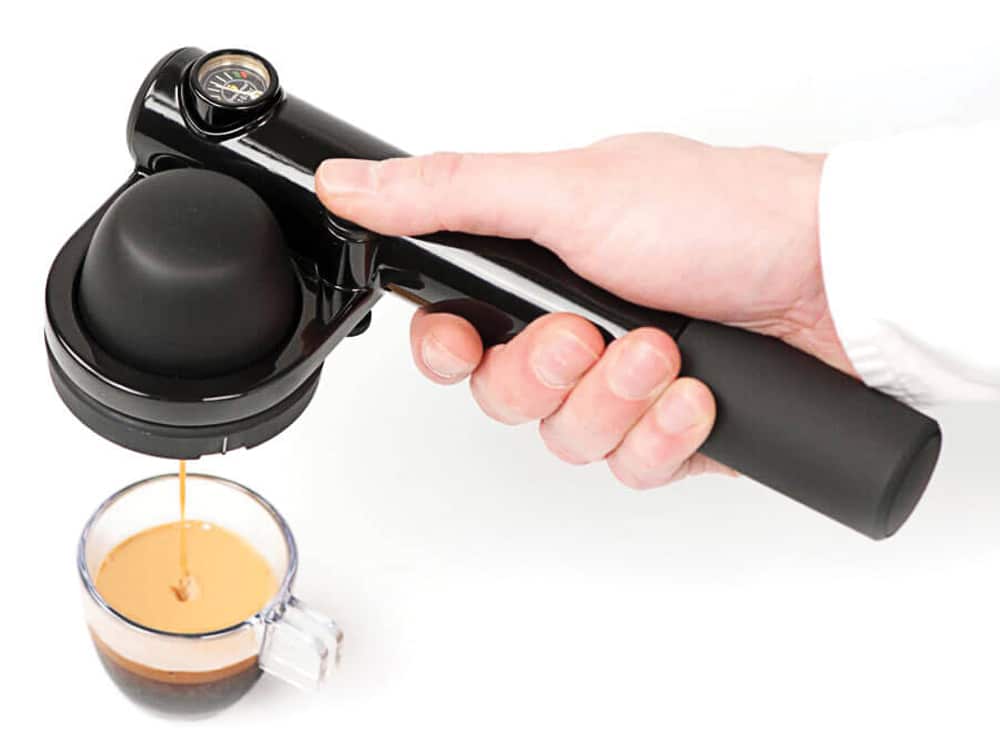
The Handpresso is small, lightweight and can use either coffee pods or ground coffee. Two basic models are available (handpresso.com; $80-$100), as well as options including coffee maker plus carry bag or case with thermos and cups ($129-$179).
Brewing Tips: Use espresso-grind coffee or pods. Don’t overfill coffee container.
Brew time: about one minute using preheated water from a thermos.
Pros: Made of lightweight, sturdy plastic or plastic with some metal. Quick. Very compact. Easy to use. Easy cleanup. Makes tasty coffee.
Cons: Small yield – one cup espresso (about 1.5 to 2 ounces) at a time.
No matter how you make it, coffee is an individualized taste — some want it strong; others like it weak or in between. Some prefer only the finest blends, and still others like supermarket brands. Whatever your preference, using one of these methods for onboard brewing will yield a pleasure like no other: savoring a steaming cup of fresh-brewed joe while watching the sun rise over your favorite cove, or as a welcome boost of warmth and aroma on a cold night watch at sea.
Lynda Morris Childress has cruised and chartered her Atlantic 70 cutter, Stressbuster, in the Greek islands for the past 15 years.
Fresh is Best
If you want a really fresh-tasting cup of coffee, consider buying whole beans and grinding them aboard. The Hario manual coffee mill is a popular, affordable choice and stows easily in a galley locker.








